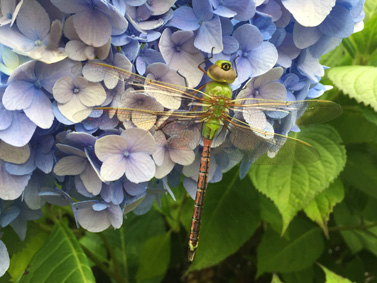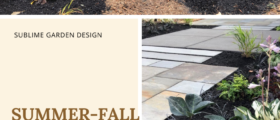Fall is here…what to do in the garden this time of year.
If you are like me you are still waking in the morning hoping to see the sun rising, only to find it dark, or hoping that we might be able to eek out one more day of 70 degree weather, only to be informed by your smart phone that today will be cloudy with a chance of rain…and a possible sunbreak in the afternoon.
I always feel a bit of resistance around the beginning of September, as warm summer breezes give way to cool foggy mornings and late evening strolls are replaced with cozy nights by the fire and a glass of red. But this year it has been especially difficult since here in the Northwest we only had what felt like two weeks of summer. Yet as much as I deny its arrival, I always eventually welcome fall with its rich tones and warm-sweater-wearing crisp days.
Observing the happenings in your garden can be somewhat the same way. We are sorry to see abundant drifts of flowers wither and curl and yet we are in awe as the rich fall foliage colors emerge. Spending some time in the garden at this time of transition will be worth it when spring returns and you emerge from your deep hibernation. But that time is a ways off…
There are many things that can be done in the garden but we have whittled them down to what we feel are the most important. Being a list-person I find that having these things easily listed to be checked off helpful.
Fall “To Do” list in the Northwest garden
For your Lawn
- Fertilize grass with an organic fertilizer. Late fertilizing encourages sugars to be stored for a quick rebound in spring.
- Thatch if necessary, aerate (every other year), and overseed.
- Add lime. The ideal ph for lawns is between 6.0 and 7.0. The best way to know your soil condition is to have a soil test done, however most soils in the Northwest tend to be acidic due to the high amount of rainfall and conifers in our area. Adding lime over time will make the soil more alkaline, which turfgrass prefers. Lime also makes the soil more hospitable to the microorganisms that help to break up clay soils and make nutrients available to plants.
- Winterize your lawn mower after the last mow of the season by cleaning off grass clippings and sharpening the blade.
Container plantings
- Freshen up containers with evergreen shrubs and perennials, grasses and fall bloomers like pansies and mums. Some of our favorite fall container plants are nandina, heather, heuchera, acorus, Algerian ivy, osmanthus, arbutus, and leucothoe.
- If you’re like me you may like to push the zonal limit a bit and use plants in containers that aren’t hardy. If you have the space (and the desire) remove and bring in any tender plants before the first frost, which in the Seattle area is usually mid-November.
- You can over-winter plants like banana, echevaria, begonia, caladium, colocasia, fuchsia, geranium, and brugmansia/datura spp (Angel’s Trumpet) in a greenhouse, basement, or garage near a window. Some plants like begonias and echivarea can be stored as houseplants. Check weekly and be sure not to let them completely dry out.
- It’s also a good idea to bring in any containers that do not have holes drilled in the bottom or that are not freeze-proof, like terracotta, to prevent them from cracking over the winter.
Planting beds
- Keep weeds pulled to avoid them going to seed. I wish there was a magic solution other than pulling but sorry to break it to you, manually pulling them is the best way to deal with pesky weeds.
- Remove spent annuals and vegetable crops. Plant cover crops in the place of next year’s veggie garden. Cover crops reduce erosion and replace the growth of weeds and add nitrogen to the soil.
- Divide and transplant perennials. Most perennials start to look pretty ratty as we start getting colder temps at night. They can be cut back to around 2-6” and divided to plant in other parts of the garden or to give to friends and fellow gardening geeks like us.
- Dig up summer blooming bulbs (dahlias, cannas, and gladiolas) and store them somewhere dry for the winter.
- Plant spring bulbs: tulips, daffodils, hyacinth, snowdrops, and crocus, as soon as night-time temps drop to around 50 degrees (and about 6 weeks before the ground freezes). Plant bulbs in a sunny location in well-drained soil in groups of 5-10. Or for even larger drifts of bulbs plant in groups of 15-30. Large bulbs should be planted 8-12” deep and smaller bulbs 4-6 “deep. If you are not sure which end is up pant sideways and they will right themselves. Cover with soil and water.There’s no need to fertilize newly planted bulbs but bulbs that have been in the ground for a year or more can benefit from a layer of nutrient rich compost or mulch. You can protect against hungry squirrels by covering bulbs with chicken wire and securing in place with pieces of wire before covering with soil.
- Root-prune large shrubs or trees plants that you intend to move or transplant in spring. To root prune run a spade wide around the drip line of the tree to sever roots. This encourages new feeder roots to develop. Ideally you should leave the tree for 2-3 months up to a year before transplanting.
- Create new planting beds. Remove areas of grass or sheet mulch large areas by putting a layer of cardboard down over grass or heavily weeded area (remove weeds if they have gone to seed) and top with a layer of mulch.
- Plant new additions. Fall is the best time for planting! Plants are entering dormancy yet are still developing roots through fall and winter. With the increased rainfall and temperature drop they will get a good start on being established when warms temps return. Late blooming perennials like sedums, aster, and ornamental grasses as well as heucheras, heathers, and colorful conifers are great plants for instant fall color and texture.
- Continue to water until rainfall starts. And don’t forget containers and plants underneath the eves that don’t get natural rainfall. Most damage occurs not because of cold but because of cold and dryness together.
- Tidy up and cut back any unruly plants and rogue groundcovers but wait until spring to do any hard pruning of trees and shrubs, and especially roses. Pruning can make plants less cold hardy, not to mention that a hard pruning this time of year when plants are going dormant may leave your shrubs looking pretty awful. Wait until late winter/early spring to do major pruning.
- Mulch. If you didn’t mulch in the spring you can do it now. A 1-2” layer of mulch will help to regulate soil temperatures, insulate plants, cover weed seeds, control erosion, and help keep water from splashing on leaves, which reduces fungal diseases. There are many different types of mulch: leaves, straw, hog fuel, wood chips, bark, cocoa bean hulls (don’t use if you have a dog), pine needles, wine corks, and composted nutrient-rich mulches. Choose the mulch that is appropriate in the area you are mulching (you probably wouldn’t want to mulch with hog-fuel in your front yard but it can work great in a woodland garden, side yard or less frequently seen area).
- Leave the leaves in planting beds to control weeds and to enrich the soil. Leaves that have fallen on the ground are full of nutrients. The exceptions to this are leaves with diseases like rust or powdery mildew, so it’s best to rake up leaves from roses and fruit trees which are often plagued with these diseases. If you have a mulching lawn mower you can run it over your lawn (with bag attached) and then spread the leaves in your planting beds or veggie garden, add them to your compost bin. The leaves will break down slowly and can be raked up in the spring or left to further decompose. You can also run your mower (bag off) over them and leave them right on the lawn. (Note: leaves shouldn’t be left to sit on the lawn without chopping them up.)
- Adjust irrigation by 50%. Plan to have irrigation winterized before temperatures drop below freezing.
- Clean, sharpen and oil tools.
- Keep a gardening journal- of what worked and what didn’t so that you can refer to it next year. Also make notes for cop rotation for next year’s veggies.
What are you waiting for? You have work to do!
Have fun, and please if you have any questions or comments please feel free to leave them below. Happy gardening!
Organized under Garden Tips & Advice.



